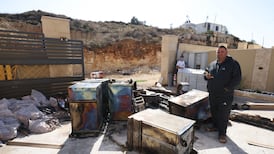At least two people were killed and 200 wounded in clashes in Iraq on Tuesday as security forces used tear gas, water cannon and live fire to disperse demonstrations over unemployment, corruption and poor public services.
The main protest took place in Baghdad, with some demonstrations in other areas of the country.
A government statement and a health ministry spokesman said 40 members of the security forces were among those injured. They did not say where the death took place.
The government statement blamed “groups of riot inciters” for the violence and said the security forces were working to ensure the safety of peaceful protesters.
In Baghdad, police opened fire in the air as some 3,000 protesters tried to cross a bridge leading into Baghdad’s fortified Green Zone, which houses government buildings and foreign embassies.
Reuters reporters saw several people with blood covering their faces. Ambulances rushed in to transport the wounded.

Anger
Security forces, who had blocked roads, used stun grenades and water cannons to push back crowds. Protesters refused to leave and so security forces opened fire.
Since similar but more deadly protests took place last year, public anger has simmered over a chronic shortage of job opportunities, electricity and clean water.
Iraqis blame politicians and officials for endemic corruption that is preventing the country from recovering after years of sectarian conflict and a devastating war to defeat Islamic State.
“This is not a government, it is a bunch of parties and militias who destroyed Iraq,” said one protestor who declined to give his name out of fear of reprisal.
Shi’ite Muslim paramilitary groups known as Popular Mobilisation Forces play a large role in Iraqi politics and have representation in parliament and government. They have been accused of controlling parts of Iraq’s economic - a charge they deny.
Lack of services
Prime minister Adel Abdul Mahdi, who chaired the weekly cabinet meeting on Tuesday, issued a statement promising jobs for graduates. He instructed the oil ministry and other government bodies to start including a 50 per cent quota for local workers in subsequent contracts with foreign companies.
Iraq saw massive protests last year which first erupted in the south, heartland of the Shi’ite majority.
Clashes took place between security forces and protesters incensed by collapsing infrastructure, frequent power cuts, and widespread corruption.
Oil-rich Iraq has suffered for decades under the rule of Saddam Hussein and UN sanctions, the 2003 US-led invasion and civil war it unleashed, and the battle against Islamic State, which was declared won in 2017.
Graft is widespread and basic services like power and water are lacking. – Reuters














